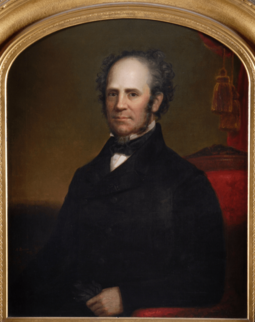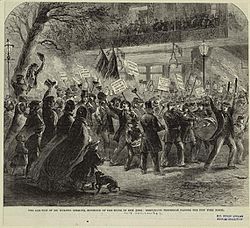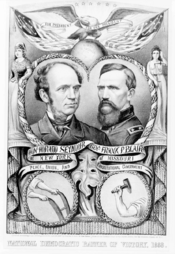Horatio Seymour facts for kids
Quick facts for kids
Horatio Seymour
|
|
|---|---|
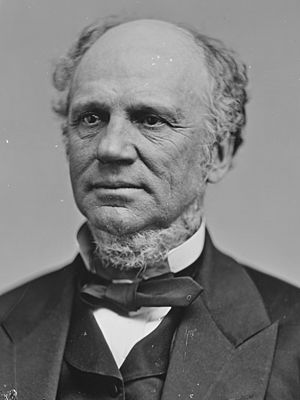
Portrait by Mathew Brady, c. 1860–1865
|
|
| 18th Governor of New York | |
| In office January 1, 1863 – December 31, 1864 |
|
| Lieutenant | David R. Floyd-Jones |
| Preceded by | Edwin D. Morgan |
| Succeeded by | Reuben Fenton |
| In office January 1, 1853 – December 31, 1854 |
|
| Lieutenant | Sanford E. Church |
| Preceded by | Washington Hunt |
| Succeeded by | Myron H. Clark |
| Speaker of the New York State Assembly | |
| In office January 7, 1845 – December 31, 1845 |
|
| Preceded by | Elisha Litchfield |
| Succeeded by | William C. Crain |
| Member of the New York State Assembly from Oneida County |
|
| In office January 1, 1844 – December 31, 1845 |
|
| Preceded by | Multi-member district |
| Succeeded by | Multi-member district |
| In office January 1, 1842 – January 31, 1842 |
|
| Preceded by | Multi-member district |
| Succeeded by | Multi-member district |
| Mayor of Utica, New York | |
| In office 1842–1843 |
|
| Preceded by | John C. Devereux |
| Succeeded by | Frederick Hollister |
| Personal details | |
| Born | May 31, 1810 Pompey, New York, U.S. |
| Died | February 12, 1886 (aged 75) New York City, New York, U.S. |
| Resting place | Forest Hill Cemetery Utica, New York, U.S. |
| Political party | Democratic |
| Spouse | Mary Bleecker |
| Relations | Henry Seymour (father) Origen S. Seymour (cousin) Horatio Seymour (uncle) Edward W. Seymour (nephew) Horatio Seymour Jr. (nephew) Roscoe Conkling (brother-in-law) |
| Education | Hobart College Norwich University (BA) |
| Profession |
|
| Signature | |
Horatio Seymour (born May 31, 1810 – died February 12, 1886) was an important American politician. He served as the Governor of New York twice. His first term was from 1853 to 1854. His second term was from 1863 to 1864.
Seymour was the Democratic Party candidate for president in 1868. He ran against Ulysses S. Grant, a Republican. Grant won the election.
Horatio Seymour was born in Pompey, New York. He became a lawyer in 1832. However, he mostly managed his family's businesses. He later became a military secretary for Governor William L. Marcy. This was his first step into politics.
Seymour was elected to the New York State Assembly. He became its speaker in 1845. He was part of the "Softshell Hunker" group within the Democratic Party. He ran for governor in 1850 but lost. He won the governor's race in 1852. During his time as governor, he tried to unite the Democratic Party. This party was divided at the time.
As Southern states threatened to leave the Union, Seymour wanted to avoid a civil war. He supported the Crittenden Compromise. This plan aimed to keep the country together. During the Civil War, he supported the Union. However, he often disagreed with President Abraham Lincoln's decisions. He won another term as governor in 1862. He continued to oppose many of Lincoln's policies.
In 1868, the Democratic Party needed a presidential candidate. Many people wanted Seymour to run. He was the chairman of the convention. He refused to seek the nomination at first. But after many votes, the convention chose him. He finally agreed to run. He lost the election to General Ulysses S. Grant. After this, Seymour did not seek public office again. He remained active in politics. He supported Grover Cleveland for president in 1884.
Contents
Early Life and Education
Horatio Seymour was born in Pompey Hill. This is in Onondaga County, New York. His father, Henry Seymour, was a merchant and politician. His mother was Mary Ledyard Forman. Horatio was one of six children. His sister Julia Catherine married Roscoe Conkling.
When he was 10, his family moved to Utica. He went to local schools there. This included Geneva College, now called Hobart College. In 1824, he attended the American Literary, Scientific & Military Academy. He graduated in 1828.
After college, Seymour studied law in Utica. He became a lawyer in 1832. However, he did not enjoy being an attorney. He spent most of his time on politics. He also managed his family's businesses. In 1835, he married Mary Bleecker.
Political Career Beginnings
Seymour's political journey started in 1833. He became a military secretary to Governor William L. Marcy. Marcy was a Democrat. Seymour held this job for six years. This experience taught him a lot about state politics. It also built a strong friendship between him and Marcy.
In 1839, Seymour returned to Utica. He took over his family's estate after his father died. He made smart investments. These included real estate, banks, mines, and railroads. In 1841, he was elected to the New York State Assembly. He also served as mayor of Utica from 1842 to 1843. He was re-elected to the Assembly in 1843. In 1845, he became the speaker.
In the late 1840s, the New York Democratic Party split. It divided into two groups: the Hunkers and the Barnburners. Seymour was part of the Hunker group. This group was more conservative. After the party split, Seymour joined the "Softshell Hunkers." This group wanted to reunite the Democrats. They hoped to bring back the party's power in the state.
First Term as Governor
In 1850, Seymour ran for governor. He was the candidate for the reunited Democratic Party. But he lost by a small number of votes. The winner was Washington Hunt, a Whig candidate. Seymour and his group supported Franklin Pierce for president in 1852. Pierce won the presidency.
In 1852, Seymour ran for governor again. He narrowly defeated Hunt in a rematch. His first term as governor of New York was challenging. He helped get approval for a loan to expand the Erie Canal. This was a big project.
However, his time as governor was difficult. The state Democratic Party was still divided. The national government's policies also caused problems. President Pierce supported the Kansas–Nebraska Act. This act was very unpopular. Seymour was indirectly linked to it through his friend Marcy. This cost him many votes. In 1854, he ran for re-election. He lost by a very small margin.
Between Governor Terms
Even after his defeat, Seymour became a key figure in national politics. He was a former governor of New York, a very large state. In 1856, some people thought he might be a presidential candidate. But he wrote a letter saying he would not run. In 1860, he was again considered for the Democratic nomination. He publicly stated he was not a candidate.
Seymour supported Stephen A. Douglas for president in both 1856 and 1860. In 1861, he was nominated for the U.S. Senate. This was mostly an honorary role. Republicans had a majority in the state legislature. So, a Republican victory was expected.
During the time when Southern states were leaving the Union, Seymour supported the Crittenden Compromise. This plan aimed to prevent the Civil War. Once the war began, Seymour supported the Union effort. But he often criticized President Abraham Lincoln's leadership. He was especially critical of Lincoln's power and limits on freedoms. He also disagreed with Lincoln's support for ending slavery.
Second Term as Governor
In 1862, the Republican governor, Edwin D. Morgan, decided not to run again. The Democratic Party chose Seymour as their strongest candidate. He accepted the nomination with some hesitation. He campaigned hard across the state. He hoped a Democratic win would limit the actions of the Radical Republicans in Washington. He won a close election against James S. Wadsworth. This was part of several Democratic victories in New York that year.
Seymour's second term was even more challenging. As governor of New York from 1863 to 1864, he was a leading Democratic opponent of President Lincoln. He disagreed with the military draft started by Lincoln in 1863. He felt it was against the Constitution. This made many people question his support for the war.
He also opposed a bill that would let soldiers vote. He vetoed the bill. He wanted voting rules to be set by a constitutional change. His opponents said this showed he was against soldiers. He also upset some people by paying state debts with gold instead of paper money. His veto of a bill for a streetcar line in Manhattan also caused problems.
During the New York Draft Riots in July 1863, he tried to calm the unrest. Republicans used this against him. They accused him of being disloyal. These problems weakened Seymour's position as governor. In 1863, Republicans won many state elections. They took control of the State Assembly. In 1864, Seymour lost his re-election bid. He was defeated by Republican Reuben Fenton in a close race.
Prominent Democratic Leader
Horatio Seymour remained an important figure in the Democratic Party. This was true both during and after his second term as governor. In 1864, he led the Democratic National Convention. Many delegates did not want the two main candidates. They looked to Seymour as a compromise choice. However, he refused to be nominated. The nomination eventually went to George B. McClellan.
After the Civil War, Seymour supported President Andrew Johnson's Reconstruction policies. He strongly opposed "Radical Reconstruction." This policy focused on giving civil and political rights to formerly enslaved people.
1868 Presidential Election
As the 1868 presidential election neared, no clear Democratic candidate emerged. Many candidates were considered. George H. Pendleton had strong support. But his plan to pay off federal debt with paper money worried some. When Seymour was asked to run, he again said no. He preferred other candidates like Thomas A. Hendricks.
At the convention, Seymour was again the chairman. Voting began on June 7. On the fourth vote, North Carolina voted for Seymour. He again said he would not accept the nomination. Two days later, during the twenty-second vote, it seemed Hendricks would win. But then, Ohio suddenly switched its votes to Seymour. Even though Seymour said he did not want to be the nominee, the delegates changed their votes. They nominated him unanimously.
Campaign for President

With the nomination forced upon him, Seymour committed to the campaign. He faced big challenges. His opponent, General Ulysses S. Grant, had a united Republican Party behind him. Grant also had the support of most newspapers. Seymour followed the tradition of not actively campaigning. However, he did tour the Midwest and mid-Atlantic states in October.
In his campaign, Seymour supported a limited government. He opposed the Republican policies for Reconstruction. His campaign also used appeals to racism. The Republican campaign, however, focused on Seymour's past actions. They highlighted his support for those who caused unrest against African-Americans.
Seymour lost to Grant in the election. Grant won a large majority of the electoral votes. Seymour never sought public office again. He stayed active in politics. He supported Grover Cleveland's presidential campaign in 1884. After Seymour's loss, the Fifteenth Amendment was added to the Constitution. This amendment guaranteed voting rights for African-Americans. It also made New York State restore voting rights for these citizens.
Later Years and Legacy
After the presidential election, Seymour remained involved in state politics. He was seen as an experienced leader. He received many honors. In 1873, he became the chancellor of Union College. In 1874, he turned down a chance to be elected to the United States Senate. He suggested Francis Kernan instead. He also refused two more attempts to nominate him for New York governor. This happened in 1876 and 1879. He also refused a final attempt to make him the Democratic presidential nominee in 1880.
Seymour was never very healthy. His health began to decline in 1876. He made one last political effort in 1884. He campaigned for Grover Cleveland for president. But his health got worse the next year. On July 4, 1885, he was chosen to represent his grandfather in the Society of the Cincinnati. In January 1886, his wife Mary became ill. Seymour's own health worsened even more. Horatio Seymour died in February 1886. He was buried in Forest Hill Cemetery in Utica, New York. Mary died a month later and is buried next to him.
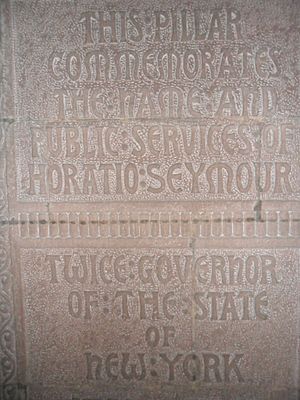
There is a memorial to Seymour at the Cathedral of All Saints (Albany, New York). Seymour, Wisconsin, was founded in 1868 and named after Horatio Seymour. Seymour Avenue in the Bronx, New York, was named for him.
Images for kids
-
Campaign badge, 1868, from the New York Public Library, Schomberg Collection
-
The Horatio Seymour memorial at the Cathedral of All Saints (Albany, New York).
See also
 In Spanish: Horatio Seymour para niños
In Spanish: Horatio Seymour para niños
- Seymour-Conkling family



